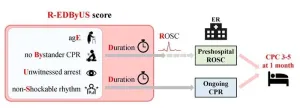(Press-News.org) Past studies have suggested that taking cholesterol-lowering statin drugs may lower individuals’ risk of developing liver cancer. In a new study of non-statin cholesterol-lowering medications, one type was linked to lower risks of liver cancer. The findings are published by Wiley online in CANCER, a peer-reviewed journal of the American Cancer Society.
Cholesterol absorption inhibitors, bile acid sequestrants, fibrates, niacin, and omega-3 fatty acids are types of non-statin cholesterol-lowering medications prescribed to manage cholesterol and lipid levels. The different classes of drugs work in different ways. A team led by Katherine A. McGlynn, PhD, MPH, of the National Cancer Institute, looked for associations between these five types of non-statin cholesterol-lowering medications and risk of liver cancer, the sixth most commonly occurring cancer globally and the third leading cause of cancer mortality.
The investigators used information from the Clinical Practice Research Datalink (CPRD), a primary care database that covers approximately 7% of the United Kingdom population. Their analysis included 3,719 liver cancer cases and 14,876 matched controls without cancer. Additional matches were also made based on individuals’ type 2 diabetes and chronic liver disease status.
Use of cholesterol absorption inhibitors was associated with 31% lower odds of liver cancer risk in the overall analysis. These medications were also linked with a lower risk of liver cancer in analyses based on diabetes and liver disease status. The study also confirmed that statins were associated with 35% lower odds of liver cancer.
No associations with liver cancer risk were observed for fibrates, omega-3 fatty acids, or niacin. While bile acid sequestrant use was associated with higher odds of liver cancer risk in the overall analysis, the results of analyses based on diabetes and liver disease status were inconsistent, suggesting that replication of these observations is important.
“As few studies have examined the effects of non-statin cholesterol-lowering drugs on liver cancer risk, the results of our study require replication in other populations. If our findings are confirmed in other studies, however, our results may inform liver cancer prevention research,” said Dr. McGlynn.
Additional information
NOTE: The information contained in this release is protected by copyright. Please include journal attribution in all coverage. A free abstract of this article will be available via the CANCER Newsroom upon online publication. For more information or to obtain a PDF of any study, please contact: Sara Henning-Stout, newsroom@wiley.com
Full Citation:
“Use of cholesterol-lowering medications in relation to risk of primary liver cancer in the Clinical Practice Research Datalink.” Shahriar A. Zamani, Barry I. Graubard, Marianne Hyer, Emily Carver, Jessica L. Petrick, and Katherine A. McGlynn. CANCER; Published Online: July 29, 2024 (DOI: 10.1002/cncr.35436).
URL Upon Publication: http://doi.wiley.com/10.1002/cncr.35436
Author Contact: Jennifer Loukissas, Director of Communications at the National Cancer Institute, at loukissj@mail.nih.gov.
About the Journal
CANCER is a peer-reviewed publication of the American Cancer Society integrating scientific information from worldwide sources for all oncologic specialties. The objective of CANCER is to provide an interdisciplinary forum for the exchange of information among oncologic disciplines concerned with the etiology, course, and treatment of human cancer. CANCER is published on behalf of the American Cancer Society by Wiley and can be accessed online. Follow CANCER on X @JournalCancer and Instagram @ACSJournalCancer, and stay up to date with the American Cancer Society Journals on LinkedIn.
About Wiley
Wiley is a knowledge company and a global leader in research, publishing, and knowledge solutions. Dedicated to the creation and application of knowledge, Wiley serves the world’s researchers, learners, innovators, and leaders, helping them achieve their goals and solve the world's most important challenges. For more than two centuries, Wiley has been delivering on its timeless mission to unlock human potential. Visit us at Wiley.com. Follow us on Facebook, X, LinkedIn and Instagram.
END
Do non-statin cholesterol-lowering drugs affect liver cancer risk?
Like statins, cholesterol absorption inhibitors are linked with a lower risk of developing liver cancer.
2024-07-29
ELSE PRESS RELEASES FROM THIS DATE:
Every minute counts: rapid and accurate prediction model for cardiac arrest treatment
2024-07-29
When it comes to treating cardiac arrest, acting quickly can mean the difference between life and death.
Researchers from Osaka Metropolitan University have developed a new scoring model, using only prehospital resuscitation data, that accurately predicts neurological outcomes of patients with out-of-hospital cardiac arrest (OHCA). This model potentially allows healthcare providers to make quick and accurate decisions upon the patient’s arrival at the hospital, ultimately improving patient care and resource allocation.
Their findings were published in Resuscitation on May 31.
Cardiac arrest can lead to death within minutes. OHCA is not uncommon and often results ...
Hypertensive disorders of pregnancy increasing in Canada
2024-07-29
In Canada, rates of hypertensive disorders of pregnancy (HDP) have increased, but the good news is there has been a decline in some related health conditions, according to new research published in CMAJ (Canadian Medical Association Journal) https://www.cmaj.ca/lookup/doi/10.1503/cmaj.231547.
Hypertensive disorders of pregnancy include chronic hypertension (high blood pressure), gestational hypertension, and preeclampsia or eclampsia. These disorders affect 5%–10% of pregnancies worldwide, and cause more than 50 000 maternal deaths and 500 000 deaths in fetuses and infants ...
Is free genetic testing really free?
2024-07-29
Free genetic testing, offered partially or fully subsidized by industry, may have trade-offs, and health systems in Canada must carefully weigh potential clinical, ethical, and legal considerations to protect patient data, authors argue in a CMAJ (Canadian Medical Association Journal) commentary https://www.cmaj.ca/lookup/doi/10.1503/cmaj.231588.
“Near- and long-term expansion in no-cost testing and industry partnership in genetics, with patient data as the commodity, is likely,” writes Kirsten ...
Health: Short-term vegan diet associated with reductions in biological age estimates
2024-07-29
Eating a vegan diet for eight weeks is associated with reductions in biological age estimations based on levels of DNA methylation — a type of chemical modification of DNA (known as an epigenetic modification) that alters gene expression but not DNA itself. Previous research has reported that increased DNA methylation levels are associated with ageing. The findings, which are based on a small randomised controlled trial of 21 pairs of adult identical twins, are published in BMC Medicine.
Varun Dwaraka, Christopher ...
Evidence-based information combats misleading and false claims on the internet and social media about the anti-Mullerian hormone test
2024-07-29
Researchers in Australia have found that when women are given accurate information about a test that indicates the number of eggs in their ovaries, they have less interest in taking the test compared to women who viewed information available online.
The researchers initiated the study, which is published today (Monday) in Human Reproduction [1], one of the world’s leading reproductive medicine journals, because of the large amount of misleading and incorrect information promoted to women about the anti-Mullerian hormone (AMH) test on websites, including fertility clinic websites, and via social media.
AMH ...
Steel industry’s net zero drive could make lower-grade iron ore viable
2024-07-29
A decarbonised steel industry that includes carbon dioxide removal techniques in its net zero arsenal could use lower-grade iron ore, according to a new study.
Steel accounts for 5-8% of carbon dioxide emissions globally. Its total emissions have risen over the past decade, largely due to increased demand.
The International Energy Agency has stated that, without innovation, the scope to limit emissions is ‘limited’. Therefore, the commercialisation of new zero-emission production processes is critical.
Innovative ...
Plasma phosphorylated tau 217 and Aβ42/40 to predict early brain Aβ accumulation in people without cognitive impairment
2024-07-28
About The Study: The results of this cohort study suggest that combining plasma p-tau217 and Aβ42/40 levels could be useful for predicting development of Aβ pathology in people with early stages of subthreshold Aβ accumulation. These biomarkers might thus facilitate screening of participants for future primary prevention trials.
Corresponding Authors: To contact the corresponding authors, email Oskar Hansson, M.D, Ph.D. (Oskar.Hansson@med.lu.se) and Shorena Janelidze, Ph.D. (shorena.janelidze@med.lu.se).
To access the embargoed study: Visit our For The Media website at this link https://media.jamanetwork.com/
(doi:10.1001/jamaneurol.2024.2619)
Editor’s ...
MRI signature of α-synuclein pathology in asymptomatic stages and a memory clinic population
2024-07-28
About The Study: In this cohort study, seed amplification assays (SAA) α-syn+ was consistently associated with nucleus basalis of Meynert (NBM) atrophy already during asymptomatic stages. Further, in memory clinic cognitively impaired populations, SAA α-syn+ was associated with NBM atrophy, which partially mediated α-syn–induced attention/executive impairment.
Corresponding Authors: To contact the corresponding authors, email Laura E.M. Wisse, Ph.D. (laura.wisse@med.lu.se) and Oskar Hansson, M.D., Ph.D. (oskar.hansson@med.lu.se).
To access the embargoed study: Visit our For The Media website at this link https://media.jamanetwork.com/
(doi:10.1001/jamaneurol.2024.2713)
Editor’s ...
Blood biomarkers to detect Alzheimer disease in primary care and secondary care
2024-07-28
About The Study: The amyloid probability score 2 (APS2) blood test and percentage of p-tau217 alone had high diagnostic accuracy for identifying Alzheimer disease among individuals with cognitive symptoms in primary and secondary care using predefined cutoff values. Future studies should evaluate how the use of blood tests for these biomarkers influences clinical care.
Corresponding Authors: To contact the corresponding authors, email Sebastian Palmqvist, M.D., Ph.D. (sebastian.palmqvist@med.lu.se) and Oskar Hansson, M.D., Ph.D. (oskar.hansson@med.lu.se).
To access the embargoed study: Visit our For The Media website at this link https://media.jamanetwork.com/
(doi:10.1001/jama.2024.13855)
Editor’s ...
Changes in Alzheimer disease blood biomarkers and associations with incident all-cause dementia
2024-07-28
About The Study: Plasma biomarkers of Alzheimer disease (AD) neuropathology, neuronal injury, and astrogliosis increase with age and are associated with known dementia risk factors. AD-specific biomarkers’ association with dementia starts in midlife whereas late-life measures of AD, neuronal injury, and astrogliosis biomarkers are all associated with dementia.
Corresponding Author: To contact the corresponding author, Priya Palta, Ph.D., M.H.S., email priya_palta@med.unc.edu.
To access the embargoed study: Visit our For The Media website at this link https://media.jamanetwork.com/
(doi:10.1001/jama.2024.6619)
Editor’s ...
LAST 30 PRESS RELEASES:
Numbers in our sights affect how we perceive space
SIMJ announces global collaborative book project in commemoration of its 75th anniversary
Air pollution exposure and birth weight
Obstructive sleep apnea risk and mental health conditions among older adults
How talking slows eye movements behind the wheel
The Ceramic Society of Japan’s Oxoate Ceramics Research Association launches new international book project
Heart-brain connection: international study reveals the role of the vagus nerve in keeping the heart young
Researchers identify Rb1 as a predictive biomarker for a new therapeutic strategy in some breast cancers
Survey reveals ethical gaps slowing AI adoption in pediatric surgery
Stimulant ADHD medications work differently than thought
AI overestimates how smart people are, according to HSE economists
HSE researchers create genome-wide map of quadruplexes
Scientists boost cell "powerhouses" to burn more calories
Automatic label checking: The missing step in making reliable medical AI
Low daily alcohol intake linked to 50% heightened mouth cancer risk in India
American Meteorological Society announces Rick Spinrad as 2026 President-Elect
Biomass-based carbon capture spotlighted in newly released global climate webinar recording
Illuminating invisible nano pollutants: advanced bioimaging tracks the full journey of emerging nanoscale contaminants in living systems
How does age affect recovery from spinal cord injury?
Novel AI tool offers prognosis for patients with head and neck cancer
Fathers’ microplastic exposure tied to their children’s metabolic problems
Research validates laboratory model for studying high-grade serous ovarian cancer
SIR 2026 delivers transformative breakthroughs in minimally invasive medicine to improve patient care
Stem Cell Reports most downloaded papers of 2025 highlight the breadth and impact of stem cell research
Oxford-led study estimates NHS spends around 3% of its primary and secondary care budget on the health impacts of heat and cold in England
A researcher’s long quest leads to a smart composite breakthrough
Urban wild bees act as “microbial sensors” of city health.
New study finds where you live affects recovery after a hip fracture
Forecasting the impact of fully automated vehicle adoption on US road traffic injuries
Alcohol-related hospitalizations from 2016 to 2022
[Press-News.org] Do non-statin cholesterol-lowering drugs affect liver cancer risk?Like statins, cholesterol absorption inhibitors are linked with a lower risk of developing liver cancer.


